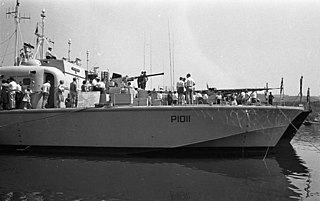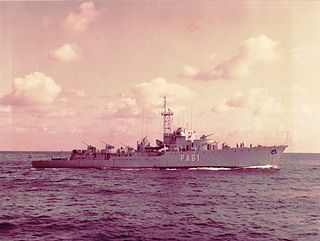
HMS Amazon was the first Type 21 frigate of the Royal Navy. Her keel was laid down at the Vosper Thornycroft shipyard in Southampton, England. The ship suffered a fire in the Far East in 1977, drawing attention to the risk of building warships with aluminium superstructure.

A motor torpedo boat is a fast torpedo boat, especially of the mid 20th century. The motor in the designation originally referred to their use of petrol engines, typically marinised aircraft engines or their derivatives, which distinguished them from other naval craft of the era, including other torpedo boats, that used steam turbines or reciprocating steam engines. Later, diesel-powered torpedo boats appeared, in turn or retroactively referred to as "motor torpedo boats" for their internal combustion engines, as distinct from steam powered reciprocating or turbine propulsion.

HMS Sealion (S07) was a Porpoise-class submarine.

HMS Torquay was a Type 12 Whitby-class frigate of the British Royal Navy. They were the first frigates to have the "V" form hull. This evolutionary design made it possible to be driven in head sea without the usual slamming which occurs with conventional destroyers of the time. Each frigate cost 3.5 million pounds and the first ship completed was Torquay in May 1956.
Vosper & Company, often referred to simply as Vospers, was a British shipbuilding company based in Portsmouth, England.
HMS Dittisham was one of 93 ships of the Ham-class of inshore minesweepers built for the British Royal Navy. Their names were all chosen from villages ending in -ham. The minesweeper was named after Dittisham in Devon.
HMS Puttenham(M2784) was a Ham-class inshore minesweeper of the Royal Navy. She was launched in 1956 and entered service in 1958. The 93 ships of the Ham class had names chosen from villages ending in -ham. The minesweeper was named after Puttenham.

HMS Tenby was a Whitby-class or Type 12 anti-submarine frigate of the Royal Navy of the United Kingdom.

HMS Whitby was a Whitby-class or Type 12 anti-submarine frigate of the Royal Navy of the United Kingdom built by Cammell Laird and Co Ltd, Birkenhead. She was launched on 2 July 1954 and commissioned on 10 July 1956.

The Brave-class fast patrol boats were a class of two gas turbine motor torpedo boats (MTBs) that were the last of their type for the Royal Navy (RN) Coastal Forces division. They formed the basis for a series of simpler boats which were widely built for export.

HMS Cachalot (S06) was a Porpoise-class submarine. Her keel was laid down on 1 August 1955 by Scotts Shipbuilding and Engineering Company at Greenock. She was launched on 11 December 1957, and commissioned on 1 September 1959.
HMS Iveston was a Ton-class minesweeper of the Royal Navy launched on 1 June 1954 by Philip and Son in Dartmouth. After her decommissioning in 1992, HMS Iveston became the Sea Cadet training ship T.S. Iveston. She was sold and scrapped in March 2015.
HMS Shoulton (M1182) was a Ton-class minesweeper of the Royal Navy.
The October class is a series of six missile boats constructed for the Egyptian Navy in the mid-1970s as a replacement for the aging Komar-class missile boats. The design of the vessels is based on the Komar class and the six ships were constructed at Alexandria, Egypt and completed by Vosper Thornycroft at Portsmouth, United Kingdom. They entered service in the late 1970s. Two were removed from service and four are still active.
HMS Brereton (M1113) was a Ton-class minesweeper of the Royal Navy. Brereton was built by the Lowestoft shipbuilder Richard Ironworks, and was launched in 1953 and entered service in 1954.

The Dealey-class destroyer escorts were the first post-World War II escort ships built for the United States Navy.
Dat Assawari was a frigate operated by the Libyan Navy. The ship was built by VT Group in the United Kingdom. It was ordered in February 1968 and delivered in 1973. The ship's design, the Vosper Mk 7 is a modified version of the Alvand-class frigate built for the Iranian Navy. The ship had an extensive refit in Italy by CNR Riva Trigoso 1979–1980 when new sensors and missiles were installed. During the refit, the ship was mined by unidentified swimmers. The vessel returned to service in 1983, but returned to Italy for repairs in 1984–1985 and 1989–1990. The frigate was reportedly scrapped in the late 1990s.
The Province-class fast attack craft, also known as the Dhofar class, is a British-built series of missile-armed fast attack craft for the Royal Navy of Oman.

The Douro class of destroyers included five ships used by the Portuguese Navy between 1933 and 1967 and two used by the Colombian Navy.

The Atrevida class was a class of six corvettes built for the Spanish Navy in the 1950s.










